ikfoundation.org
The IK Foundation
Promoting Natural & Cultural History
Since 1988


 Crowdfunding Campaign
Crowdfunding Campaignkeep knowledge open, connected, and growing on this textile history resource...
LACEMAKERS AND HANDICRAFT: 1750-1775
– a Case Study of Traditions and Commerce
Laces had been a luxury item long before the mid-18th century, primarily visible today via artworks often focusing on clothing details showing off impressive craft skills of complex needle or bobbin-made examples. To work as a skilled lacemaker, with specialist knowledge in producing laces for sale was undoubtedly backbreaking work over many long hours. In contrast to when lacemaking was part of a leisure activity for young ladies of the elite strata of society, such textile craft was evidently depicted as a relaxing and enjoyable moment in a comfortable or even extravagant domestic sphere. At times a lady seems to have preferred other sorts of handicraft – like embroidery – but laces still being an important part of her fashionable silk gown. This essay will focus on a selection of artworks, sumptuary laws and preserved handmade laces from Sweden, Denmark and France, but similar traditions and fashions could also have been applied to several other European countries or in the North American colonies.
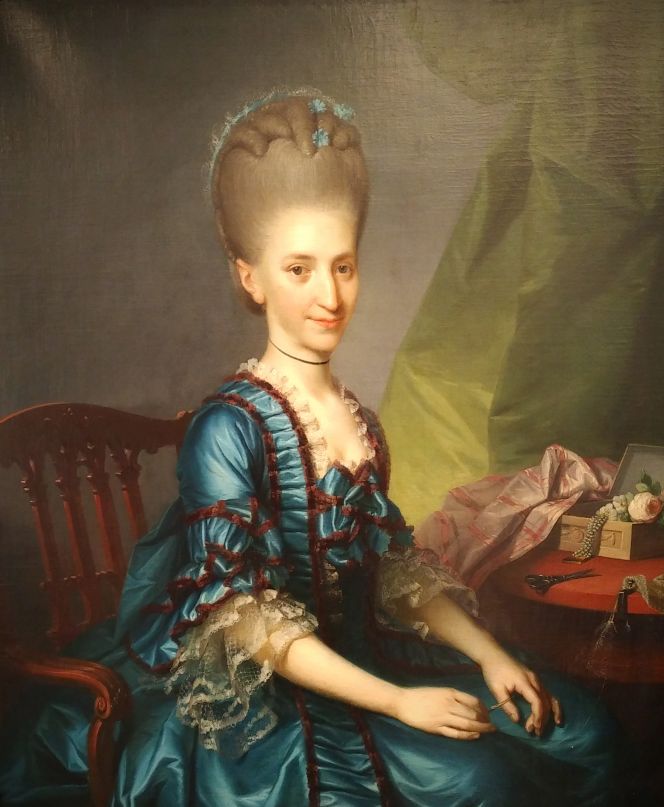 A portrait by the Danish artist Jens Juel (1745-1802) of an unknown fashionable young lady wearing a Robe à la Française of finest silk, in the early 1770s. Her ongoing handiwork – a netlike tulle – seems to imply that she previously had made the three-layered lace ruffles for her elbow length sleeves. Such a fine net ground was made with the long needle in her hand by making a loop and twisting the thread repeatedly from side to side, assisted by a pair of scissors and a hook fastened on the table. When the net had reached the required length, it was preferably stretched in a frame and added with needle-work of a chosen design. (Private Art Collection, København, Denmark). Photo: Viveka Hansen, The IK Foundation.
A portrait by the Danish artist Jens Juel (1745-1802) of an unknown fashionable young lady wearing a Robe à la Française of finest silk, in the early 1770s. Her ongoing handiwork – a netlike tulle – seems to imply that she previously had made the three-layered lace ruffles for her elbow length sleeves. Such a fine net ground was made with the long needle in her hand by making a loop and twisting the thread repeatedly from side to side, assisted by a pair of scissors and a hook fastened on the table. When the net had reached the required length, it was preferably stretched in a frame and added with needle-work of a chosen design. (Private Art Collection, København, Denmark). Photo: Viveka Hansen, The IK Foundation.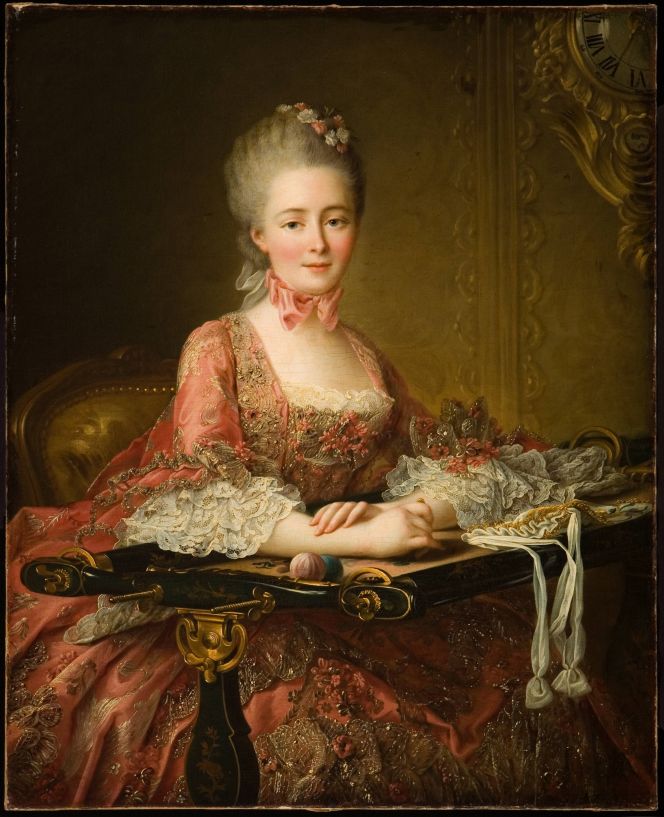 This contemporary portrait of Marquise de Caumont La Force in 1767, shows three-layered ruffles at her elbow length sleeves of a more lavish design than on the panting above. The young French lady wore a court dress of the most exquisitely woven silk and the attached lacework was most probably professionally made, a so-called ‘Point d’Angleterre de Flandre’ made in Brussels. A type of needle-lace, which was one of the most admired at the time. However, the lady portrayed here was also engaged in handicraft, in her case it seems to be tambour embroidery – judging by the slightly visible small wooden hook in her left hand – stretched on an elegant frame. Oil on canvas by François-Hubert Drouais (1727–1775). (Courtesy of: David Owsley Museum of Art Ball State University, No. 1995.035.125. Public Domain).
This contemporary portrait of Marquise de Caumont La Force in 1767, shows three-layered ruffles at her elbow length sleeves of a more lavish design than on the panting above. The young French lady wore a court dress of the most exquisitely woven silk and the attached lacework was most probably professionally made, a so-called ‘Point d’Angleterre de Flandre’ made in Brussels. A type of needle-lace, which was one of the most admired at the time. However, the lady portrayed here was also engaged in handicraft, in her case it seems to be tambour embroidery – judging by the slightly visible small wooden hook in her left hand – stretched on an elegant frame. Oil on canvas by François-Hubert Drouais (1727–1775). (Courtesy of: David Owsley Museum of Art Ball State University, No. 1995.035.125. Public Domain).Linen or silk lacework of this kind was detachable so that the delicate handmade laces could be removed for washing, starching and ironing. Additionally, the double or even triple layers of scalloped sleeve ruffles were popular at the time and included many meters of wide lace, which had the advantage of being useful on more than one gown. It may also be noticed that such delicate silk gowns and matching stomachers could not be washed; soft brushes and airing were instead a vital part of caring for silk garments. Wool would usually be beaten or brushed clean and was very seldom washed. Whilst linen would be put to soak in lye to remove stains, if soap was used, the dirty clothes had to be boiled.
Bobbin lacemaking appears to have roots in the earlier known techniques of passementerie, pleating and embroidery, judging by preserved images and documents from the 16th century. Genoa, Milano – possibly also other city-states in present-day Italy – and Flanders were the areas that initially and continuously developed the finest lacework of this kind. The bobbin laces together with Venetian embroidered needle laces and similar styled exquisite textile craft from other districts, became widely desired accessories by the wealthy around Europe during the following two centuries. Exports and all sorts of trade became extensive, off and on, and were restricted by sumptuary laws in various countries.
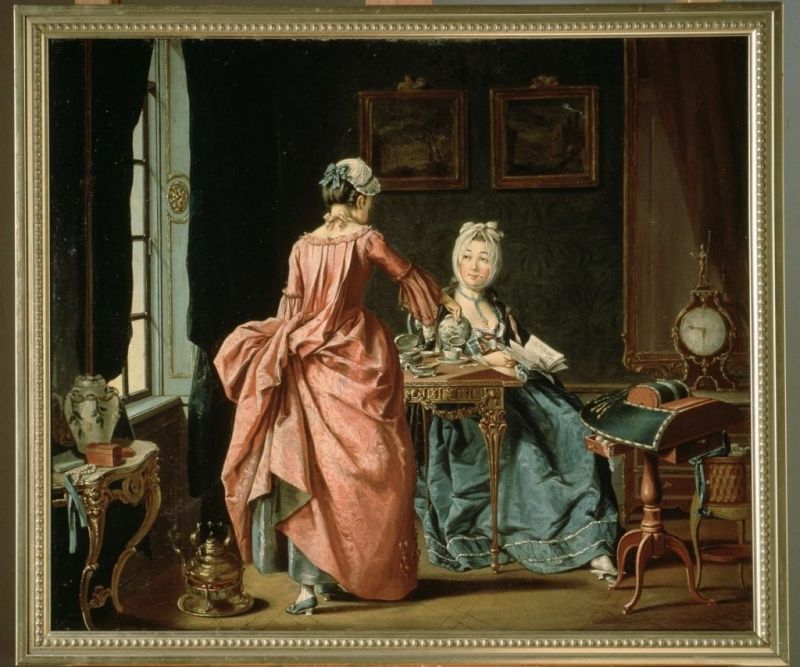 This oil on canvas by Pehr Hilleström in 1775 may be studies from several angles of a wealthy home in 18th century Sweden. The lady’s relaxed everyday life surrounded by silk fabrics, pearls, porcelain, gilded furniture and much more in the luxurious interior also included some useful or industrious occupations – like reading and bobbin-lace making. The lacemaking was depicted as an ongoing work, as it seems like a narrow lace assisted by pins and a “reasonable” number of bobbins in use, not more than ten pairs. The useful wooden stand was fitted with practical drawers, for safe-keeping of fine linen threads, pins and additional bobbins. To be compared with the much wider contemporary professionally Swedish-made laces on the image below. (Courtesy of: Nordic Museum, Stockholm, Sweden. NM.0177655.1, Digitalt Museum).
This oil on canvas by Pehr Hilleström in 1775 may be studies from several angles of a wealthy home in 18th century Sweden. The lady’s relaxed everyday life surrounded by silk fabrics, pearls, porcelain, gilded furniture and much more in the luxurious interior also included some useful or industrious occupations – like reading and bobbin-lace making. The lacemaking was depicted as an ongoing work, as it seems like a narrow lace assisted by pins and a “reasonable” number of bobbins in use, not more than ten pairs. The useful wooden stand was fitted with practical drawers, for safe-keeping of fine linen threads, pins and additional bobbins. To be compared with the much wider contemporary professionally Swedish-made laces on the image below. (Courtesy of: Nordic Museum, Stockholm, Sweden. NM.0177655.1, Digitalt Museum).To wear a superfluous amount of wide, extremely technically advanced laces had several purposes. Fashion and decorative features were the most obvious in combination with showing off one’s high standard of living. That is to say, it became clearly visible to each and everyone how impossible it was to actually do any type of manual work when sleeves, collars, etc, were ornamented with luxurious lacework. Additionally, the design of the laces was of vital importance; like, for instance, the connection between light and shadow in the ornamentation – via a distinct flowery motif on a tulle-like ground – gave a clearer perspective of the patterning. Effects of silver or gold threads could further emphasise sumptuousness and glimmer in a candlelit room.
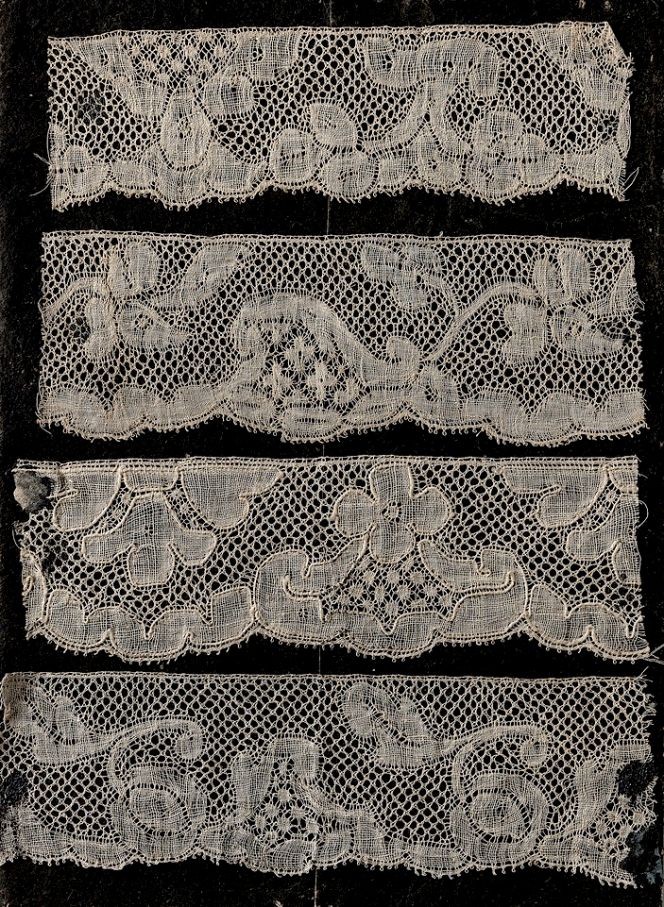 These linen bobbin-lace samples were part of the professor of economics, Anders Berch’s extensive collections in mid-18th century. According to research by the late textile historian Elisabeth Thorman: Anders Berch’s son, the notary Christer Berch, probably collected these lace samples in Vadstena at his visit here in 1759. Vadstena was the centre for exceptionally fine and complex bobbin-lace making in Sweden, even regarded of “Flandern style”. More or less every household in the town with surrounding areas had active lacemaking women during this time and such fashionable linen laces were sold via pedlars to all strata of society all over the country. Among many uses as layered ruffles on elbow length sleeves for ladies of the nobility as well as decorative features on shirts and caps in farming communities. (Courtesy of: Nordic Museum, Stockholm, Sweden. Anders Berch Collection. Digitalt Museum Image, no. NM.0017648B:23B).
These linen bobbin-lace samples were part of the professor of economics, Anders Berch’s extensive collections in mid-18th century. According to research by the late textile historian Elisabeth Thorman: Anders Berch’s son, the notary Christer Berch, probably collected these lace samples in Vadstena at his visit here in 1759. Vadstena was the centre for exceptionally fine and complex bobbin-lace making in Sweden, even regarded of “Flandern style”. More or less every household in the town with surrounding areas had active lacemaking women during this time and such fashionable linen laces were sold via pedlars to all strata of society all over the country. Among many uses as layered ruffles on elbow length sleeves for ladies of the nobility as well as decorative features on shirts and caps in farming communities. (Courtesy of: Nordic Museum, Stockholm, Sweden. Anders Berch Collection. Digitalt Museum Image, no. NM.0017648B:23B).During the 18th century, lacemaking and the use of lace as fashionable or traditional decorations for a restricted geographical area also influenced much wider groups in society. Handicraft and professionally produced laces alike. From a Swedish perspective, Anna-Maja Nylén – among other even earlier textile historians – made in-depth research into this subject in the 1950s and 1960s. She noted: ‘The 18th century became the delicate bobbin lace making most expansive period via the laces from Flanders. This lacemaking and its lace patterns were spread together with the Flanders’ linen thread. The traders in linen thread also distributed lace patterns with needle holes for bobbin-lace making to ease the circulation. In Sweden, provided by the authorities, lace makers from Flanders were also recruited to work as teachers’. This initial influence of professional lacemakers was concentrated in Vadstena and continued to expand over the century, as illustrated above, together with a wide range of locally developed lacemaking traditions in many provinces in Sweden.
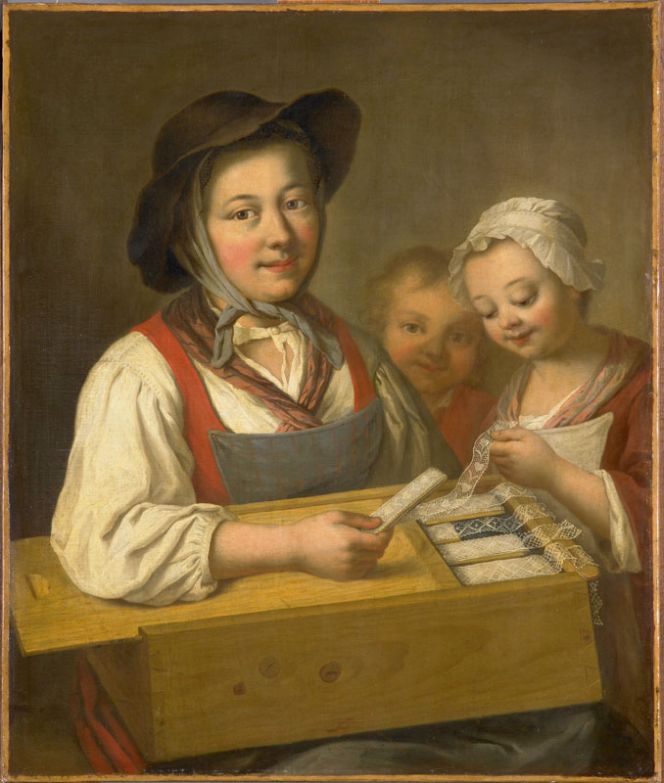 This oil on canvas by the French painter Gabriel Gresley (1710-1756) dating circa 1751, gives a unique glimpse into how a lace-seller kept the delicate handmade laces, finely folded and placed in a protective as well as displayable wooden box. This method of avoiding dust, dirt and moments of unnecessary handling of the delicate bobbin- and needle laces alike, must also have been an important aim for 18th century pedlars in other countries. (Courtesy of: Musée des Beaux-Arts de Dijon, France. No. CA 309).
This oil on canvas by the French painter Gabriel Gresley (1710-1756) dating circa 1751, gives a unique glimpse into how a lace-seller kept the delicate handmade laces, finely folded and placed in a protective as well as displayable wooden box. This method of avoiding dust, dirt and moments of unnecessary handling of the delicate bobbin- and needle laces alike, must also have been an important aim for 18th century pedlars in other countries. (Courtesy of: Musée des Beaux-Arts de Dijon, France. No. CA 309).The sumptuary laws reached their peak of severity and extent in 1766 with Kongl. Maj:ts Nådige Förordning Emot Yppighet och Öfwerflöd (His Majesty’s Directive against Luxuriance and Superfluity) in Sweden, which not only wanted to minimise the use of satin, silk, lace and luxury accessories of various kinds among the commoners but also to limit the quantity of cloth used for unnecessary ostentation among the ladies of the aristocracy, pointing out for example that [quotes in translation] ‘For the prevention of a harmful luxuriance in Ladies’ costumes, all trains on Ladies’ costumes of whatever kind are forbidden as from the 1 January 1767…’. These new restrictions also included ‘silk laces and thread laces’ of wider designs, which was regarded as an unnecessary luxury. The only exemption was ladies making visits at the court, as it in such cases still was possible to wear extensive sleeve ruffles in layers as in the artwork above. Whilst in the sumptuary law of 1770, laces were also included in a multitude of restrictions linked to men’s clothing: ‘All Male Persons, in general, are forbidden at a Penalty of one Hundred Rixdollar Silver, the concern of the informer alone, to wear Silk Velvet, and Silk fabrics in Clothing, Lining, by which is meant Coats, Frock-coats, so-called Surcoats, Jackets and Waistcoats; Likewise forbidden at the same Fine are all Galloons and Embroidery in Gold, Silver, Silk or any other kind, except for what officers and the parading Burghers of the town have the right to wear on their Hats and Caps; Also forbidden for Male Persons at the same Fine are Lace and Mountings on Canvas for Cuffs…’
How strictly those sumptuary laws in Sweden were adhered to in a growing consumer society is difficult to say for sure, but any fines cost both the wearer and the tailor a great deal, which must have had the intended effect. The trade in textile goods, domestically as well as abroad, was in any case considerable, which regarding the traditions of 18th century lace also can be studied in Carl Magnus Könsberg’s book on trading commodities, published in 1768. It may be assumed that his information was amassed before 1766 when the strict sumptuary laws became a reality. That publication is arranged like an encyclopaedia from A to Z and provides a fascinating insight into the profusion of desirable trading commodities in circulation in Sweden. In concluding words, one such merchandise was ‘Spetsar’ [Laces], which originated from various towns and districts in Europe: Made in Antwerp, Brussels, Mecheln, Löven, Gent, Brabant, Flanders, Valenciennes, Arras, Hennegau, Artois, Dieppe, Havre de Grace, Honfleur, Harfleur, Caen, Picardie, S. Denis, Champagne, Lottringen, Schwarzenberg, Eibenstock, Annaberg, Aberdam, Joachim's thal, Altenberg, Husum, Tönningen and Holstein…Black silk laces are made in Italy, sent from Verona and Roveredo’.
Sources:
- Branting, Agnes, ‘Knytning, knyppling och språngning’, Fataburen 1907, pp. 105-119.
- Collin, Maria, ‘Skånska nätspetsar’, Fataburen 1918, pp. 143-149.
- Hansen, Viveka, Textilia Linnaeana – Global 18th Century Textile Traditions & Trade, London 2017 (pp. 28-29 & 302).
- Johansson Sally, Knyppling, Borås 1964.
- Kongl. Maj:ts Nådige Förordning, Emot Yppighet och Öfwerflöd, Stockholm 1766.
- Kongl. Maj:ts Förnyade Nådige Förordning Emot Yppighet och Öfwerflöd, Stockholm 1770.
- Könsberg, Carl Magnus, Kort anwisning på in och utrikes handelswahror såsom apotheques saker, ädla stenar, wijner, spetserier, färggräs, frukter, siden, linne, ylle och bomulstyger..., Norrköping 1768 (Quote in translation: ’Spetsar’ [Laces] p. 53).
- Nylén, Anna-Maja, Hemslöjd, Lund 1968 (Lacework: pp. 295-314, quote in translation: p. 302).
- Thorman, Elisabeth, Svenska spetsar, Stockholm 1940 (p. 55).
Essays
The iTEXTILIS is a division of The IK Workshop Society – a global and unique forum for all those interested in Natural & Cultural History.
Open Access Essays by Textile Historian Viveka Hansen
Textile historian Viveka Hansen offers a collection of open-access essays, published under Creative Commons licenses and freely available to all. These essays weave together her latest research, previously published monographs, and earlier projects dating back to the late 1980s. Some essays include rare archival material — originally published in other languages — now translated into English for the first time. These texts reveal little-known aspects of textile history, previously accessible mainly to audiences in Northern Europe. Hansen’s work spans a rich range of topics: the global textile trade, material culture, cloth manufacturing, fashion history, natural dyeing techniques, and the fascinating world of early travelling naturalists — notably the “Linnaean network” — all examined through a global historical lens.
Help secure the future of open access at iTEXTILIS essays! Your donation will keep knowledge open, connected, and growing on this textile history resource.
been copied to your clipboard




– a truly European organisation since 1988
Legal issues | Forget me | and much more...
You are welcome to use the information and knowledge from
The IK Workshop Society, as long as you follow a few simple rules.
LEARN MORE & I AGREE







